
It was a beautiful creature; what a shame it had to die.
But death is a natural consequence of life. As certain for all of us as tomorrow’s dawn.
Though I never saw one before, even at a distance I could recognize the body lying on the trail. Its rust, white, and gray fur were beautiful even in death.
It was a gray fox (Urocyon cinereoargenteus). I find this animal intriguing and have long wanted to see one. A dog that climbs trees! How unusual is that? But I had hoped to see one alive.
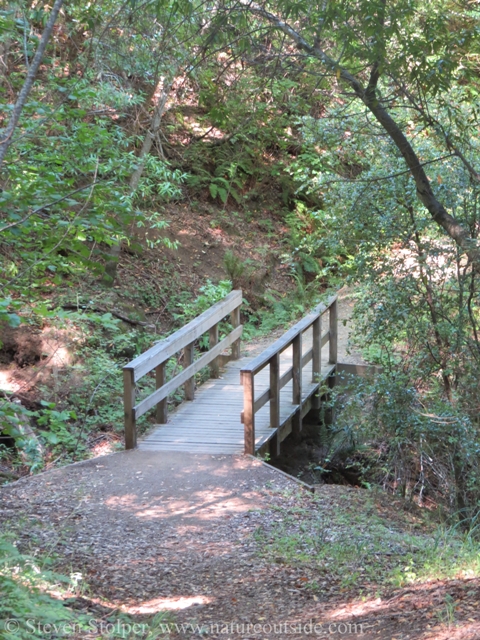
Hiking through mixed forest.
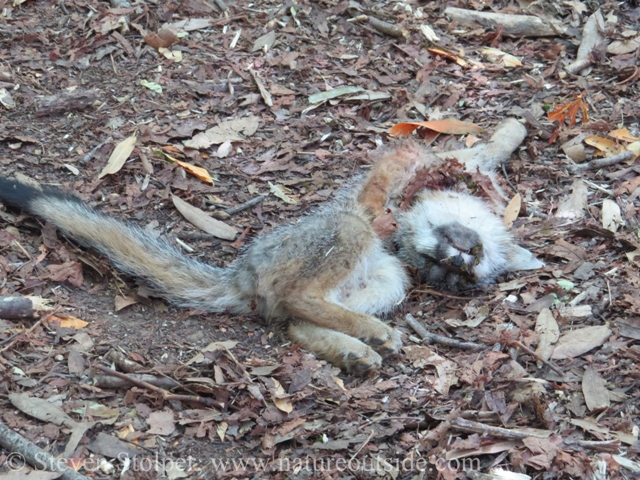
Gray Fox (Urocyon cinereoargenteus)
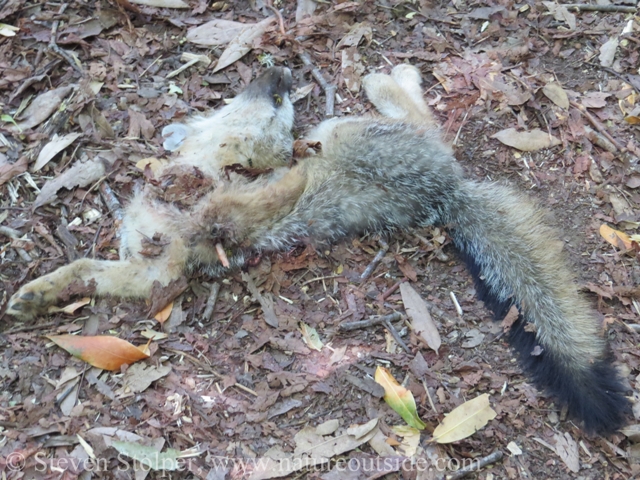
This one was about 22 inches long with a 15-inch tail
The Dog that Climbs Trees
Gray foxes are secretive. But they live almost everywhere in North America and even range into parts of southern Canada. Gray foxes have short legs and shun parts of the country where deep winter snow makes travel difficult for them. They also avoid areas that have little brush or trees to provide cover. As a result, you will not find them in the northern Rockies or Great Plains. In my part of Northern California, they inhabit forests and areas overgrown with brush. They also remain along some parts of the coast of San Francisco Bay.
They are relatively small animals:
- Weight: Generally ranges from 6.6 – 11 pounds
- Body length: Between 2.6 – 3.6 feet long
- Tail length: Their tails can add another 15 inches to their length
What amazes me is their ability to climb trees. Their curved claws are semi-retractable. This is more like a cat than a dog! Along with their claws is the ability to rotate their forelegs. Gray foxes use these adaptations to climb vertical trees. They hug them with their front legs and shimmy using their back legs for propulsion. Trees provide refuge from predators and can help them locate prey.
Gray foxes are crepuscular and nocturnal. Their diet makes them highly adaptable. They eat mammals, birds, fruits, invertebrates, berries, nuts, and grains. In my area the menu likely consists of pocket gophers, brush rabbit, mice, wood rats, and birds. Manzanita and toyon berries are also readily available.
Gray foxes still live along the shores of San Francisco Bay, almost in the midst of our suburban sprawl. But what was once a continuous “greenway” around the bay is being interrupted by development. As a result they are becoming increasingly rare due to habitat destruction.
A local expert told me a wonderful story of how he was contacted by a large high-tech company whose campus abuts the Bay. They had spotted gray foxes on their grounds and were worried for the safety of their workers. They wanted him to trap and remove the foxes. I laugh every time I try to conjure an image of gray foxes pouncing on high-tech workers. Once he explained that the foxes were harmless, the company actually became proud they lived on their property.
Nature’s Classroom
Classroom learning is great. But if you spend enough “dirt time” in the outdoors you learn that the land itself instructs. These lessons, both unexpected and insightful, can give you a view of our natural world that few possess. The trick is to be observant and inquisitive. Nature is the professor who never repeats herself. You must take advantage of her lessons when she gives them.
I examined the fox’s inanimate form looking clues to its demise. I also paid close attention to the area surrounding the body.
I found the fox in a wooded area shortly before 10:00 AM. It was a strategic area in that a water source was nearby. It was also near a junction of several trails.
Already the temperature was approaching 80 degrees. The sky was clear and there was no wind. It was a holiday weekend when most people rise later in the day and enjoy outdoor barbeques with their families. So I suspect that I was the first human to encounter the creature.
I could see signs of disturbance around the body. But I could not make out any tracks. Leaves had fallen from the trees and covered the trail around the corpse. Dry leaves clung to obvious wounds where blood had glistened recently.
It was a small animal. It’s 22-inch body was lying in the center of the trail. The carcass looked fresh, less than 8 hours old. Yellow jackets crawled in and out of the fox’s mouth and nostrils. They were attracted by moisture still present in the body, and the chance to harvest flesh. Wind blowing overnight could account for the leaves on the trail and in its wounds.
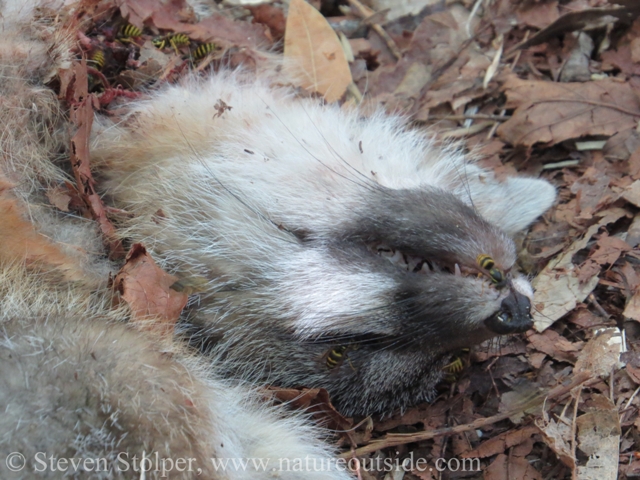
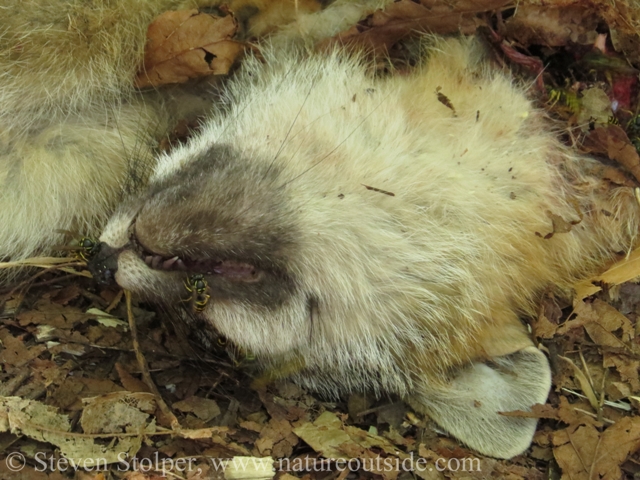
The fox suffered a laceration to its lower neck, toward the base of the throat. A gash continues from its throat down its flank for a short distance. You can see in the pictures below that the body had not been consumed. Its killer left the fox in a prominent location, in the center the trail, without eating it.
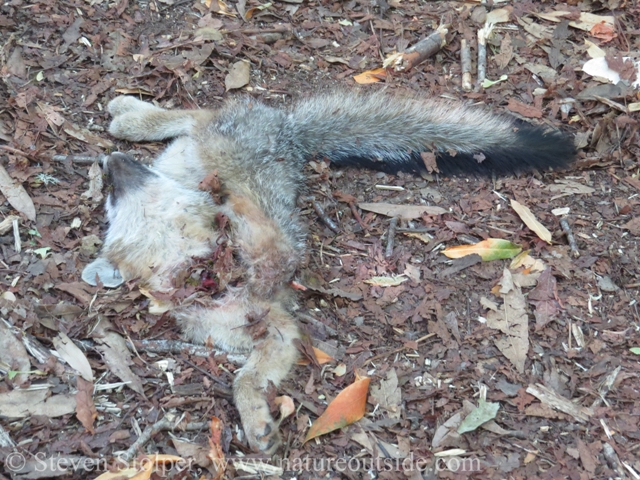
The fox suffered wounds near the base of the throat and along its flank, near the throat.
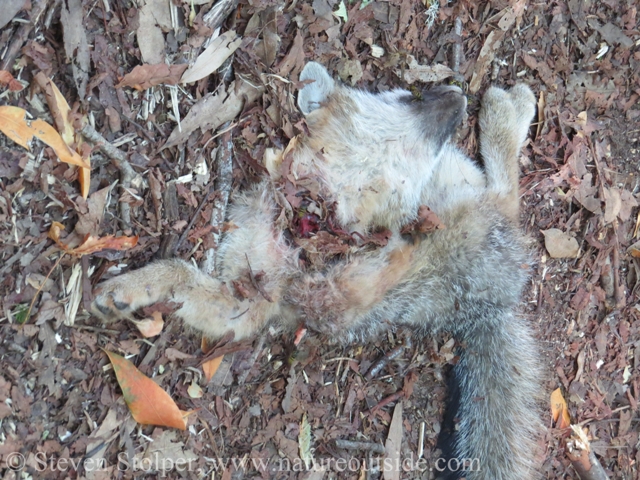
Leaves fell onto the wounds in the night and adhered to the moisture
Tell Me a Story
When I see something in nature that I am trying to understand I take the following approach:
- Observe all I can
- Ask questions
- Construct a narrative
Most people can become better observers. And it is easy to convince people of the need. But asking questions seems difficult for most people to do. Yet this is a key skill. Questions give rise to more questions, which in turn open new pathways of thought. Asking questions glues observation to understanding. So make sure that when you observe something in nature you ask, “What does it mean?”
As questions are asked and pondered, I build a narrative. I try to put together a story that explains what I see. It must also be consistent with what I know of the natural world. Often when a piece doesn’t fit, I discover that I made a bad assumption, or what I “know” is not correct. The story also lets you step into the animal’s place. When you do this, you begin to see things from the animal’s perspective. You can gain key insights into its behavior.
So What Happened?
So what happened to our poor Gray Fox? I showed my pictures to a friend who is an accomplished tracker. Here are his thoughts:
To me, this sure looks like the work of another canine (best guess, Coyote) that grasped the fox by the throat while choking and probably shaking it. There is intense competition between the various canines out there.
I tend to agree with his assessment.
But we may never know for sure – and that’s OK! For many beginning animal trackers, coming to grips with this uncertainty is difficult – especially when television tells us that all of life’s mysteries are solved with certainty in about 30 minutes (give or take commercial breaks).
Hopefully soon, I will get the chance to see a live Gray Fox in the wild.
References
These are affiliate links.
Behavior of North American Mammals, Mark Elbroch and Kurt Rinehart
Mammals of California, E.W. Jameson, JR. and Hans J. Peters
Mammals of the Pacific States, Lloyd G. Ingles
If you enjoyed this article, you may also enjoy other articles in the nature section and the tracking section.



Leave a Comment